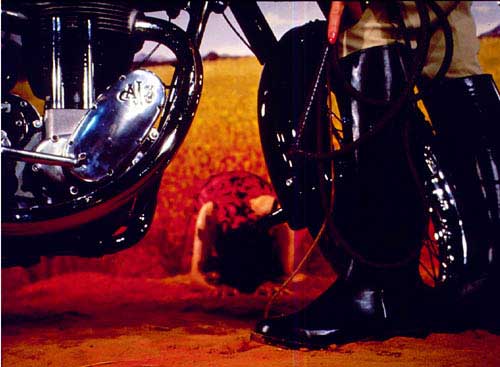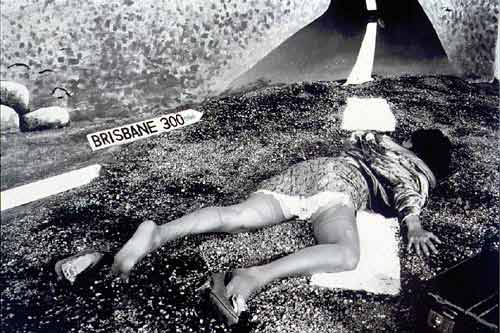|
January 22, 2004
Tracey Moffat has appeared briefly before in this post. She currently has an exhibition at the Museum of Contemporary Art in Sydney.
What initially attracted me to the studio-based work of Moffat was the way she blurred the boundaries between cinema, photography and the visual arts. The form is a set of stills for a film whose narrative was about the trials of a poor but restless coloured girl in rural Australia who wanted 'something more' out of life than her lot in the white patriarchical 'colonial' society.
This is an image from an early piece of work:

Tracey Moffatt, from Something More, 1989
A racist fantasy?
This is the image I previously posted is from the same body of work and it expresses the dreams of a young women in an Asian dress who desires to escape rural Australia---and move to Brisbane?

And a third image from the same work highlights the violence in the sexual relationships in post colonial society:

What strikes me now is the interplay between sex, violence and race in a society scarred by colonialism. Moffatt shows 'the native' in various contexts that include sexual slavery. This art depicts a white patriarchical domination that it opposes.
These images are contaminated with domination even as they produce something distinct from domination (a desire for liberation). They do not produce a positive or utopian image. Rather they express a negative image since they show the negative aspects of the social reality that aboriginal women live in regional Australia. In doing so the images contest the conservative Australian nationalism that celebrates settler Australia, its positive values and achievements, and glossing over the violence wrought by the settler's domination and conquering of nature and indigneous peoples.
The images express the violence of our historical reality that has been made mute. Moffatt recognizes the repression and exploitation in the white black relations are the actual conditions of existence.
It's a tragic photo-narrative, as the young women dies on the road to Brisbane--and freedom:

|

this really is a wonderful article. it has helped me tremendous for my school assignments. Cheers gary!